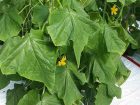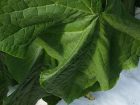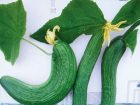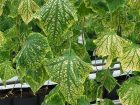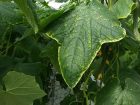
News
Understanding the Language of Plants – part 2
In this second of a two-part series, we learn some of the ways cucumbers communicate with us when they’re hungry or overfed…and even when they’re having to deal with chilly nights.
May 10, 2016 By Dr. Mohyuddin Mirza
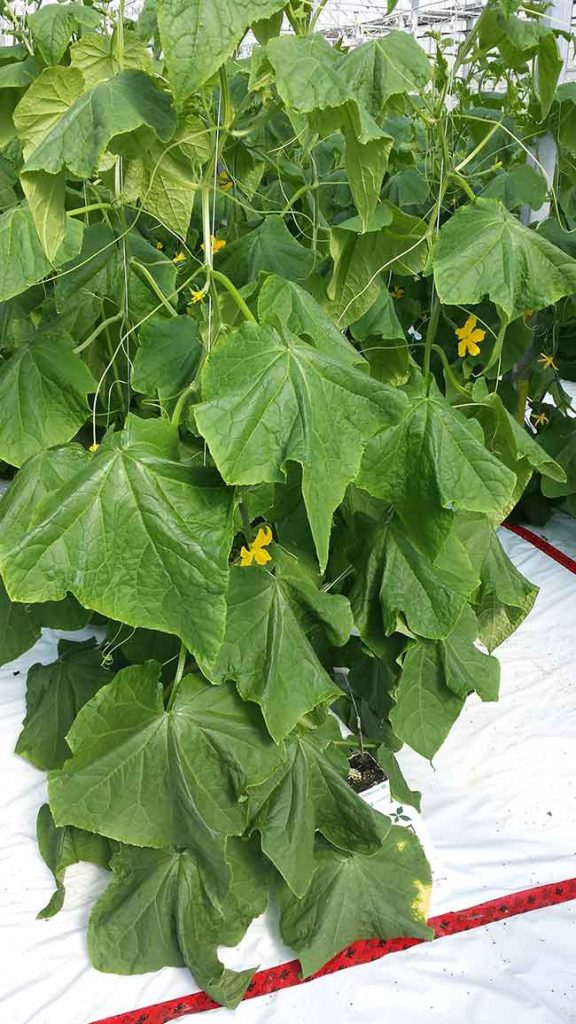 A cucumber crop in Alberta in early March, including (above) a close-up clearly showing an example of “elephant ear leaves.”
A cucumber crop in Alberta in early March, including (above) a close-up clearly showing an example of “elephant ear leaves.” June 2016 – I view cucumbers as a fascinating crop to grow and to watch grow. With the arrival of mini cucumbers in the marketplace, I am finding the fruit harvest from seeding to maturity is even faster than regular Long English (LE) cucumbers.
For example a commercial grower shared the information that a crop of minis seeded on Jan. 21 of this year and transplanted on Feb. 10 had a first harvest that started on Feb. 27. This means the first harvest took place in 37 days from seeding during this part of the season. Supplemental light was used at an intensity of 12 moles/m2/day.
In the case of regular LE cucumbers, it took 49 days during similar light conditions.
Because of its fast growing nature, the plant responds very quickly to become vegetative or generative to climate control, irrigation practices and stresses. In order to achieve above-average yields per square metre, one must understand the signals of plants.
There is no doubt that through the use of computers we gather a lot of data, but understanding the language of plants themselves is important.
Here are a few examples of what the plant is trying to tell us and after listening to it, what you can do to remedy the situation.
EXAMPLE #1
The pictures on the previous page were taken in early March. The lower photo is a close-up of a leaf. The plant had already reached the wire and was 60 days old. What it is displaying are “elephant ear leaves,” a vegetative signal by the plant. Look at leaves bending down and how the flowers are “weak.” It was another two weeks before the grower started the first picking. The plant is sending more assimilates to leaves compared to fruits.
Elephant ear leaves is an indication of a cooler night temperature that results in a lower 24-hour average temperature. In this case it was close to 18 C, while at this stage of growth it should be around 20.5 to 21 C.
It was recommended to increase the night temperature and bring the 24-hour average up. I am sure cucumber growers understand the strategies to deal with temperatures. There is average day temperature, average night temperature, temperature differential, pre-night and post-night temperatures, and how these temperatures are ramped up and down. These temperatures are adjusted based on daily light conditions.
EXAMPLE #2
This is an example of when a plant is trying to tell you that something is wrong with your temperature strategies. It was producing cucumbers nicely and suddenly leaves are coming out. Such leaves can come out on the stem end, blossom end or in the middle. This is a definite signal of the plant moving from generative to vegetative growth. In Canada most of the nights are cooler and if a grower decided to turn the boiler off, they could expect such leafy growth from fruits of cucumbers.
The remedy to turn the direction around from vegetative to generative is to remove such fruit as soon as possible and then bring the 24-hour average temperature up.
EXAMPLE #3
In this case the cucumber plant was desperate to tell the grower something for several weeks. However, while the grower observed the symptoms, he or she was not able to do something about them. The grower was trying to develop organic protocols for cucumbers and could not find a suitable source of magnesium and potassium. “I am deficient in magnesium,” is what the plant is trying to say. “You see that my veins are green and my interveinal area is yellow. Pay attention to the edges of my leaves. That is potassium deficiency.”
So learn to diagnose nutritional problems and take action early to reduce the misery and suffering of plants. A plant cannot make enough chlorophyll to manufacture its food if it is lacking in magnesium.
EXAMPLE #4
I would like you to notice three things in this picture. First is the light interveinal chlorosis, second is yellowing along the edges, and third is that the leaves are standing upward with good strength on the petioles.
In the language of plants, this cucumber is trying to tell us the following:
- “That light chlorosis spread all across my surface shows you are loading me too much. I am trying to send as much food as possible to the fruits. That is my priority. Please help me to balance myself. Also, I would like you check my root health as well. My oxygen levels are getting below 4 ppm and you know what it means to me. My roots cannot function properly and this fungus pythium is hanging around waiting to attack my hair where I absorb water and nutrients.”
- “My leaf edges are trying to tell you something. Do you know that I am ‘bleeding’ when you are not watching? My roots are telling me that you are giving me water and nutrients a little late. I am trying to shut my systems and you are still giving me plenty of water. I hope you know what I am talking about. This is my root pressure. I am trying to close my stomata because nighttime is coming and you are still supplying me with water. In case you don’t know, this bleeding is called ‘guttation’ in my language. If you don’t change your last watering to adjust to my need, this guttation will become serious and you know there is food in these water droplets. Vultures, such as botrytis, are hanging around. If they get their chance they are going to attack me and then you are going to take some action. I will not be able to give you those seven cucumbers per square metre per week.”
- “You know I like those strong leaf petioles of mine. When I compared myself with the leaves in the very first pictures, where the leaves are down, I would like to thank you because you have given me strength by using potassium silicate regularly. You recall that one day your pump got stuck and I did not get my dose of silicon, and you know what happened. Within two days, that darn white fungus was all over my leaves! My food manufacturing capacity was reduced by 50 per cent. I was really suffering but I am glad you noticed it quickly and fixed the pump. My food manufacturing capacity is back. In case you need to know what I am talking about, here is the picture (at right) you took.”
Reading a plant should be a dedicated task on a daily basis. Grab your camera, walk through the crop, and find out what plants are trying to tell you!
Dr. Mohyuddin Mirza is an industry consultant. He can be contacted at drmizaconsultants@gmail.com.
Print this page
